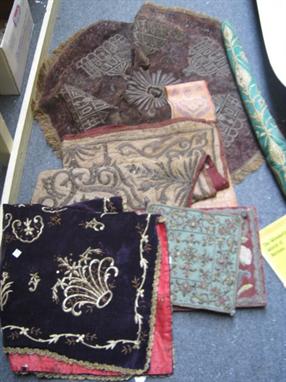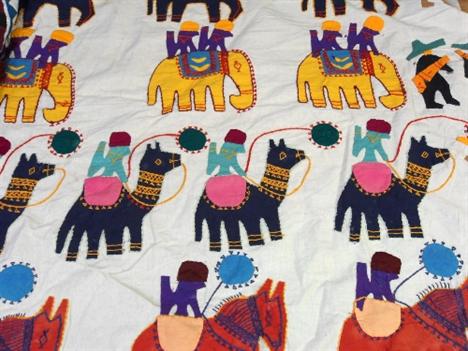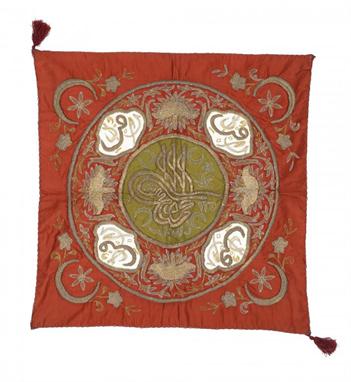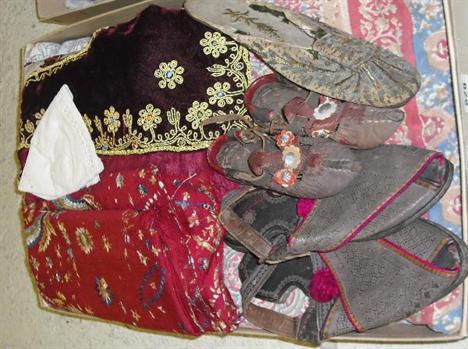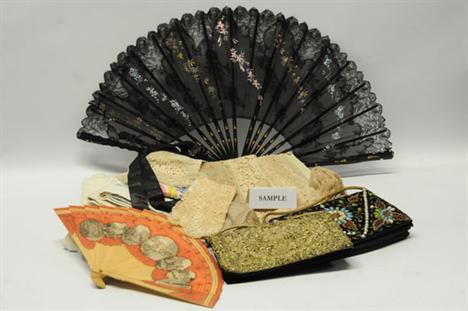We found 13526 price guide item(s) matching your search
There are 13526 lots that match your search criteria. Subscribe now to get instant access to the full price guide service.
Click here to subscribe- List
- Grid
-
13526 item(s)/page
CARLO BUGATTI, WALNUT ARMCHAIR, CIRCA 1900, with embossed copper decorations, the rectangular back covered in vellum and painted with a frieze of poppies, supported by turned uprigghts on a studded vellum seat on crossed vellum covered supports, 60cm wide, 104cm high, Note: Carlo Bugatti was born in Milan on 16 February 1856. Although he worked with ceramics, musical instruments, silverware, and textiles, he is best known for his furniture designs. The first show of Bugatti furniture was at the 1888 Fine Arts Fair in Milan. Influenced by Gothic, Moorish and Oriental styles, Bugatti used inlays of exotic woods, copper, pewter and vellum in his designs. In the summer of 1888 his work was displayed at the Italian Exhibition at Earls Court in London, his first international show. His furniture was awarded an honorary prize at this exhibition and his characteristic furniture style began to find avid devotees around the world. In New York, the Waldorf Astoria’s Turkish Salon was furnished with Bugatti pieces. Further shows followed in Amsterdam and Antwerp, and international newspaper reports and reviews contributed to his growing fame. In 1900 his furniture was awarded the silver medal at the Paris World Fair. Exhibited: The Amazing Bugattis`, Royal College of Art, London, 1979
Josep Grau-Garriga, Spanish, b.1929, Bon Diatardor, 1978, mixed textiles tapestry wall hanging, wool, rope and hemp, 220x210cm, labelled and signed. (may be subject to Droit de Suite) Note: Josep Grau-Garriga was born in Sant Cugat, Cataluna in 1929. He went on to train at the Barcelona Faculty of Fine Arts and is now recognised as an accomplished artist with work in several major museums and public collections, including the Metropolitan Museum of Art in New York. He was inspired by traditional tapestries such as those displayed in his native Catalonian churches. However, he found the traditional weaving methods limiting and therefore began to explore the possibilities of producing forms of three dimensional tapestry and consequently achieved a strong sculptural effect such as that evident in `Bon Diatardor.` Grau-Garriga also introduced other materials in addition to the traditional wools and silks used giving his works texture and adding to their abstract forms. The works were designed to be viewed at all angles and hence further challenging the traditional one dimensional tapestries that had once inspired him.
A frame and a collection of loose textiles, the frame containing an 18th century Chinese embroidered floral rosette on a golden silk velvet ground, 52 x 47cm (21.5 x 18.5in), the eleven loose textiles including cut sections, mainly Chinese and an oriental mauve silk panel embroidered with pairs of cockerels scrapping, 104 x 61cm (41 x 24in) (12)
JESSIE MARION KING (Scottish 1875-1949) Sisters pencil on vellum 22.5cm x 13.5cm Note : Jessie M King (1875-1949) was one of the most commercially successful designers and illustrators to emerge from Glasgow at the end of the 19th century. King worked in many media, but won international recognition for her book illustrations, producing images for more than 200 over a period of 50 years. At the same time, she was making and selling greetings cards, bookplates, paintings, glazed ceramics, batik textiles, as well as designs for fabrics, children`s furniture, silver, enamelwork and jewellery. Jessie M King was born in Bearsden, Glasgow, and studied at Glasgow School of Art from 1892 to 1899. Between 1899 and 1907, she taught courses in book and ceramic decoration at the School, inspiring the next generation of students. In 1920 she and her husband Ernest Archibald Taylor, also a designer and artist, moved their private art school from Paris to Kircudbright in south-west Scotland, and the couple lived and worked there for the rest of their lives.
Vintage Textiles: An early 20th century lace makers pillow in original trunk complete with assorted bead mounted pins, bone lace bobbins, lace cards (pricked) also a selection of assorted vintage clothing to include Victorian black straw and lace bonnet, yellow ground silk and silver thread hand sewn runner, shawl, embroidered apron, smoking cap etc
A Rare Carved Oak Linenfold Centre Table. The rectangular three plank top above trestle supports joined by panelling enriched with fine linenfold carving on both sides and adjoining large shaped brackets at the top & base corners. Raised on large sledge-form feet. 32 ins (82 cms) in height, 38 ins (97 cms) in width, 27 ins (69 cms) in depth. [A similar example sold in Sotheby`s Chateau de Cornillon, Loire, France: Important Gothic & Renaissance Furniture, Works of Art & Textiles sale 31 October 2006, Lot 8].
Collection of 19th century textiles, including an early Victorian double sided Paisley cream ground stole with deep blue woven detail, a printed paisley shawl (holed), together with a flat weave stole, a crazy quilt lady`s work bag, a selection of 1930-1950`s handbags (three), a collection of kid gloves and sundry scarves, including a scarf by Maggy Rouf, Paris in original packaging. A Cosimax hot water bottle, circa 1940`s by Dunlop in original box in unused state, together with a set of three 1950 table standing taper stick holders, a vintage make up box for theatre, a selection of early 20th century hand worked garments, a selection of machine lace, together with two fur capes, circa 1930`s.
SIR WILLIAM RUSSELL FLINT, RA, PRWS, RSW (1880-1969) BELLE NAGEUSE. signed, inscribed by the artist with the original title Monique (Tempera) on a frament of the original frame preserved, tempera, 32 x 60.5cM. Painted in 1937. Provenance: Mrs D B Lucas; thence by descent to the present vendor. Exhibited: Royal Academy, Diploma Gallery, Exhibition of Works by Sir William Russell Flint, 1962, No 127 (lent by Mrs D B Lucas). In the entry in the RA Catalogue Sir William Russell Flint wrote about Belle Nageuse: "Any orthodox practitioner in tempera would be horrified if he knew the speed at which-of necessity- this elegant, accomplished and confident plunger was painted. I had a slight leaning or bent, or tendency, perhaps even an inclination towards a predilection- to imitate the manner of Thomas Love Peacock- for my nageuse, whom I had known from her childhood, and I parted with this picture of her with a pang. Now, normally, she helps to decorate the drawing -room of a very lovely mansion in Somerset, but here, in our Diploma Gallery, she will recline, just for a month or two, and keep an alert eye on every quizzical soul who comes along. A consummate watercolourist and draughtsman, Flint`s early training as a lithographer instilled the discipline that combined with vision and temperament affords him a unique position in the history of the medium. His lively watercolours of nubile dancers or models, all sublimely graceful and exuding confidence, sometimes reclining, sometimes striding or otherwise poised, have an almost magnetic attraction. Careful composition draws the eye around the subject which always harmonises with the vibrancy of bright, reflected colour of textiles, sand or sea. His work of the 1930s and `40s, occasionally with the merest hint of Art Deco, is at the same time of all periods, from Classical Antiquity to the present. The artist and writer Adrian Bury (1891-1991) thought Flint "...the greatest master technically of the elusive watercolour method of art". He also wrote in the Introduction to Ralph Lewis`s biography that "...at his best his work is perfect and without criticism". In expressing this opinion Bury surely had in mind works such as Belle Nageuse. It is one of those personally selected by Flint for the 1962 Exhibition in the Royal Academy`s Diploma Gallery. Painted in 1937 the original title of Belle Nageuse was Monique, the name it bears inscribed in Flint`s hand on the back of the frame. He chose the new title purposely for the 1962 Exhibition and the model is the same as that for Alethea, also painted in tempera which was exhibited at the Royal Academy in 1935, No 609. In both these and other pictures of the period, the model is reclining on, or wears what appears to be, the same bright red Chinese embroidered silk robe. Several other outstanding works on paper by the artist have appeared on the market in recent months, in particular Alethea (Sotheby`s, 29 April 2009, lot 100, £99,650) Danza Montana and Variations IV (sold in these `rooms, 1 May 2009, lots 782 and 783, £78,000 and £84,000 respectively) and Belle Poseuse, (Sotheby`s, 29 August 2007, lot 179, £96,000). . ++ In very fine condition in 18th c style giltwood and composition frame as supplied to the late owner by Frost & Reed Ltd. Not previously offered for sale
A Corolle Brooch, by Lea Stein, circa 1980, the three dimensional laminated celluloid brooch depicting a lady`s face, in brown and gold hues, measures 4.6cm by 6.4cm and An Attila Brooch, by Lea Stein, circa 1990, the three dimensional laminated celluloid brooch depicting a standing cat, in purple, measures 4.6cm by 10.4cm (2). Lea Stein was born in Paris in 1931. She married Fernand Steinberger in the early 1950`s and he perfected a technique for laminated celluloid acetate, known as rhodoid, sometimes interspersed with textiles, lace or metal. This is the material Lea Stein uses to make her whimsical jewellery. It is thought she began producing jewellery in the late 1960`s until 1981, and after a break came back to it in 1988 on a reduced scale, producing only a couple of designs each year.
-
13526 item(s)/page



